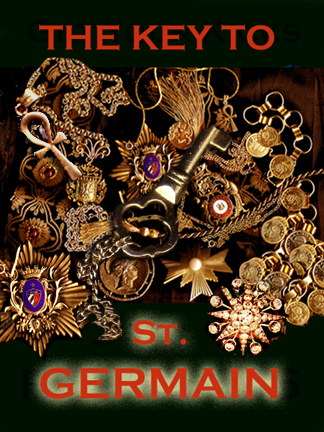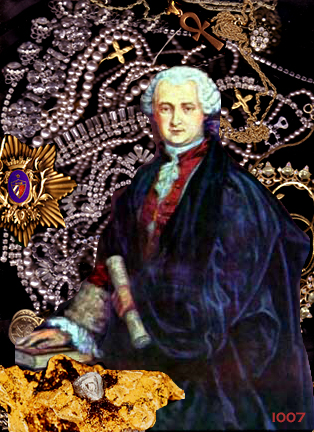St. Germain Code
Top Secret Esoterics of THE TRIANGLE BOOK of St. Germain
ST. GERMAIN’S TOP SECRET CODE REVEALED
The Triangle Book of St. Germain
By Iona Miller, 8/2007
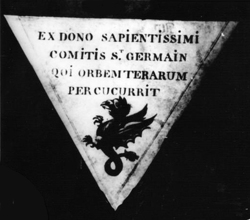
"I am today, I am yesterday, I am tomorrow. As I pass through recurrent births I am ever young and vigorous..."~Egyptian Book of the Dead
"The Comte de St. Germain was certainly the greatest Oriental Adept Europe has seen during the last centuries." ~ H.P. Blavatsky
"He was perhaps, one of the greatest philosophers who ever lived. The friend of humanity, wishING for money only that he might give to the poor, a friend to animals, his heart was concerned only with the happiness of others." ~Memoires de Mon Tempe, p.133, A.A. Le Landgrave Charles, Prince de Hesse (Copenhagen, 1861)
MASONIC SECRET OF ST. GERMAIN:
Longevity, Ye Olde-Fashioned Way
It should be clear by now that the knowledge of God that the Hermetic initiation is supposed to bring is not an external knowledge of one being by another, but an actual assumption by the initiate of the attributes of God: in short, divinization. The way of Hermes is the ‘way of immortality’; and its end is reached when the purified soul is absorbed into God, so that the reborn man, although still a composite of body and soul, can himself fairly be called a god. ~ Garth Fowden, The Egyptian Hermes
Hermetics begins and ends in the quest for eternal life -- that which is immortal within us. All other goals are subordinate this prime directive. Man becomes a mortal god and God is an immortal man. We can potentially ascend to the heights and depths of being and find they are one in the same – the secret of the whole cosmos lies at the root of matter. What we find there is Primordial Awareness of the pure potential of being, which is truly beyond time and therefore immortal –Cosmic Zero Point. A noetic experience renders the initiate immortal.
St. Germain had The Secret. That secret became a legacy of Manly Palmer Hall (MPH) and his Philosophical Research Society (PRS). It was his supreme treasure, which he kept safely hidden in his vault. The two parchment cipher texts now reside in the Getty Research Institute, likewise deep in their library vaults.
Just what was the secret of this mighty Dragon? This secret shaped his birth, his life and his legacy to the whole world. Like his predacessor Sir Francis Bacon, his true lineage was political dynamite, so he led a double life of deception to insure his survival. The secrets were manifold: secret birth, secret wisdom, secret societies, secret life.
This wisest adept in Europe reserved his greatest gift for his wisest companions. St. Germaine recorded his version of THE SECRET for health, wealth and long life in his legendary TRIANGLE BOOK, and apparently made copies for his closest circle of initiates. But it seems the entire secret was never entrusted to a single individual, as the copies of the book are curiously not identical, containing different illustrations.
We might deduce that to properly work the formulae in the book, one required the Emblems and Sigils it described. Is this why Manly Palmer Hall possessed two copies of the book, each with different glyphs? It begs the point, were there other copies with even more illustrations required to initiate the whole current -- to attain magical immortality?
Hermetic Life Extension
Those who think the Egyptians did not teach reincarnation should remember that the Soul (the Ego) of the deceased is said to be living in Eternity: it is immortal. Osiris was a god of resurrection. A Rubric to one of the versions of the lxivth Chapter of the Theban Recension of the Book of the Dead said that the Chapter was "found" during the reign of Semti. The Chapter was revised, edited, rewritten, or received some kind of literary treatment, during the reign of the fifth king of the 1st Dynasty. The Chapter to which this Rubric is appended says :----"I am Yesterday, "and I am Today ; and I have the power to be born a second time."
But, did these ancient Egyptians believe in reincarnation? Herodotus tells us that's where the ancient Greeks learned about it. The Triangle Book implies as much, calling its text "The Holy Magic revealed to Moses discovered within an Egyptian monument..." We've now discovered such texts as The Book of the Dead and the Pyramid Texts which deal with life after death, the Egyptian obsession.
Herodotus, the Greek historian (5th century B.C.), wrote that
the Egyptians were the first to teach that the human soul is immortal, and at the death of the body enters into some other living thing then coming to birth; and after passing through all creatures of land, sea, and air (which cycle it completes in three thousand years) it enters once more into a human body, at birth.
The theory of reincarnation is often ascribed to Pythagoras, since he spent some time in Egypt studying its philosophy and, according to Herodotus (bk. ii, § 123), "adopted this opinion as if it were his own."
In the Corpus Hermeticum, Thoth -- Tehuti -- was the Mind of the Deity, whom the Alexandrian Greeks identified with Hermes. For example, one of the chief books in the Hermetica is the Poimandres treatise, or Pymander. The early trinity Atum-Ptah-Thoth was rendered into Greek as theos (god) -- demiourgos or demourgos-nous (Demiurge or Demiurgic Mind) -- nous and logos (Mind and Word). The text states that Thoth, after planning and engineering the kosmos, unites himself with the Demiurgic Mind.
There are other expressions proving that the Poimandres text is a Hellenized version of Egyptian doctrine. An important concept is "making-new-again." The treatise claims that all animal and vegetable forms contain in themselves "the seed of again-becoming" -- a clear reference to reimbodiment -- "every birth of flesh ensouled . . . shall of necessity renew itself." G. R. S. Mead interprets this as palingenesis or reincarnation -- "the renewal on the karmic wheel of birth-and-death." (Thrice-Greatest Hermes, 1: 94; 2:55.)
Reincarnation has been connected with the rites of Osiris, one of the Mysteries or cycles of initiation perpetuated in Egypt. The concept of transformation as recorded in the Egyptian texts has been interpreted in various ways. De Briere expresses it in astronomical terms: "The sensitive soul re-entered by the gate of the gods, or the Capricorn, into the Amenthe, the watery heavens, where it dwelt always with pleasure; until, descending by the gate of men, or the Cancer, it came to animate a new body."
Herodotus writes of transmigration, i.e., that the soul passes through various animals before being reborn in human form. This refers not to the human soul but to the molecules, atoms, and other components that clothe it. They gravitate to vehicles similar in qualities to their former host's, drawn magnetically to the new milieu by the imprint made by the human soul, whether it be fine or gross. It is quite clear from the Book of the Dead and other texts that the soul itself after death undergoes experiences in the Duat (Dwat) or Underworld, the realm and condition between heaven and earth, or beneath the earth, supposedly traversed by the sun from sunset to sunrise.
Egyptologist Dr. Margaret A. Murray, in "The Splendour that was Egypt" states, "The ka-names of the first two kings of the XIIth dynasty show this belief clearly. Amonenhat I's name was 'He who repeats births', and Senusert I's name was 'He whose births live.' In the XIX dynasty the ka-name of Setekhy I was 'Repeater of births'..."
In Manfred Lurker's "The Gods and Symbols of Ancient Egypt" we find another quote from The Book of the Dead, "Undergoing my repeated births I remain powerful and young."
Ralph M. Lewis, Past Rosicrucian Imperator, encouraged Rosicrucians to distinguish between those teachings used by some Egyptian Priesthood to instill fear and those teachings of the advanced Egyptian Mystery Schools to provide enlightenment. Mr. Lewis related, "There is no doubt that the conception of reincarnation had its inception in Egypt.
What we know is that both St. Germain and Manly Palmer Hall lived to a ripe old age and remained mentally vibrant. Can this obscure arcane text -- one of the rarest occult manuscripts -- be the secret of their longevity? The book is alleged to be Egyptian in origin. Hall can be seen with the book in a portrait, which appears as frontpiece in his FREEMASONRY OF THE ANCIENT EGYPTIANS. Egypt's contribution to the human race can be expressed in the Hermetic teaching "Death does not exist, and man never steps outside of universal life; nevertheless, conscious immortality must be gained by each individual for himself."
Here, for the first time, the text translation appears publically with the withheld 5 illustrations of the two copies, and examples of the arcane crypto key. Even in the originals, it is difficult to make out the precise glyphs of the sigils, but arguably their magical potency is intact. Sigils and emblems often contain hidden meanings, since they are visual shorthand, which can be "read" for their symbolism. Carl Jung used this method as the traditional basis of his alchemically inspired psychology.
It seems Manly Palmer Hall took the obligatory accompanying curse seriously, for he never revealed his treasure.
render unworthy my divine bounty and you would not have the success for
which you have obtained hope.
Secrets have a way of keeping themselves, even when hiding in plain sight. The quality of these reproductions is limited by the photographic slides of the originals. They were taken during the 1970s surreptitiously in the PRS vault, most likely for another famous 20th Century adept. We can only conjecture why he resorted to subterfuge but such shenanigans are commonly reported in occult circles. Today, PRS says the book is available to view as a photocopy or microfilm of the originals, which were sold at auction but no one seems to have seen them.
LEGEND OF St. GERMAIN
St. Germain claimed to possess the secret of eternal youth, one of the two traditional goals of alchemy. He never seemed to age. For an entire century he maintained the physical appearance of a man between forty and fifty years old. He could do just about anything. Baron de Gleichen tells in Sourvenirs de Charles Henri, baron de Gleichen (1868), that according to his acquaintances, St. Germain had the appearance of a man of fifty years old.
The Comte de St. Germain, “der Wundermann,” is a legendary figure. Little historical fact is known of this Hungarian Adept, a genius or charlatan, depending on your point of view. The Rosicrucians claim he was Sir Francis Bacon in a previous, or perhaps even extended life. New Agers count him among the Ascended Masters. He is strongly linked with the Freemasons, Rosicrucians and Knights Templar. He could allegedly astral travel or bilocate. He understood herbs and plants, made medicines and produced an elixir of youth.
Lineage
The self-styled Count has shadowy origins and his birth and death dates are unknown, as is his true identity. Saint-Germain was thought to be the love child of the widow of Charles II of Spain, or a Sephardic Jew from Portugal, although Theosophists glorify him as the son of Franz-Leopold Ragoczi II, the prince of Transylvania.
He openly appeared in Leipzeg in 1777 as Prince Ragoczy and as the Graf Tzarogy, an anagram for Ragotzy (Ragoczy). Some evidence suggest he was raised by the Duc de Medici and educated at the University of Siena. This removed him from his father's poitical struggles with the Austrian Empire over the throne of his principality of Siebenburgen. His father led conspiracies of noblemen against the Austrian Empire, but he was defeated and had his properties confiscated. The family name was lost but his father provided for his third son in his will, leaving a legacy of valuable property.
His birth is estimated around 1690. Some believe he still lives. But he either died around age 80-94, or pretended to die on February 27, 1784 in the German court of Prince Charles of Hesse-Kassel, a fellow alchemist. His longevity is in close accord with the 100-year lifespan goal of The Triangle Book, give or take a decade.
Calling him “the man that doesn’t die,” many continued to insist that the jewel-trading Count was very much alive. Freemason documents indicate that he represented French Masons at a meeting in 1785. Madame de Genlis claimed to have seen him in Vienna in 1821. Several travelers in the 1800's were sure they saw the miracle worker in the Far East and other parts of the world. He reputedly travelled to Africa, India and China.
Reportedly, Rakoczi has had numerous incarnations. He was, successively, Saint Alban (third century C.E.), Proclus (a Neoplatonic philosopher, 410-85 C.E.), Roger Bacon (1220-92), Christian Rosencrutz (1378-1484), Hunyadi Janos (1387-1456), Robertus the monk (sixteenth century), and Francis Bacon (1561-1626). In his last incarnation he was a Hungarian prince, the last surviving member of the Hungarian Rokoczi family, and known throughout Europe as the Comte de St. Germain.
Theosophists Madame Blavatsky and Annie Besant (1896) both separately claimed to meet the Count, incarnated as a "Master," or spiritual leader. In 1930 Guy W. Ballard, hiking in northern California, likewise claimed to meet the Ascended Master on the side of Mount Shasta in his book Unveiled Mysteries (1934). He established the Saint Germain Foundation.
Fluent in all European languages, his aliases included: Christian Rosenkreutz, Prince Rakoczi in Dresden, Marquis de Montferrat, Count Bellamare in Venice, Chevalier Schoening in Pisa, Cevalier Weldon in Milan, Count Soltikoff in Genoa, M. deZurmont in Brussels, and Count Tazarogy in Schwalbach. In Paris, the Hague, London and St. Petersburg he was Comte de St. Germain. This was no attempt at deception, but the common practice of nearly all adventuresome members of royal families at the time -- simply travelling incognito.
Mastermind, Mystic & Philosopher
Relating events of centuries past, the Count would deliberately lead credulous listeners to believe that he had been present. "These fools of Parisians believe that I am five hundred years old," he once remarked to a friend. "I confirm them in this idea because I see that it gives them much pleasure — not that I am not infinitely older than I appear."
He always dined alone and simply. Politically astute and known for his grace and courtliness, he abstained at lavish parties, prefering conversation to consumption. He attributed his youthful appearance in part to his sobriety and a diet mostly of oatmeal, (Magre). He was likely vegetarian, or nearly so. So, we could surmise he had a low cholesterol diet, certainly conducive to long life. He also used his own herbal tonics and alchemical nostrums, perhaps including monoatomic gold, called "white powder."
*
New American Cyclopædia xiv. 266 says: "He is supposed to have been employed during the greater part of his life as a spy at the courts at which he resided." His spying seems to have been in the service of forwarding a libertine agenda, for increasing the freedoms of all. Generally, he is described as "a man of learning," "a lover of truth," "devoted to the good," and "a hater of baseness and deception." Louis XV repeatedly declared he would not tolerate any mockery of the Count, who was of high birth. He was granted a suite of room in the royal Chateau de Chambord, and spent many evenings at Versailles.
He was well-respected by the nobility and a necromancer by this report of Landgraf von Hessen-Phillips-Barchfield: "...it is now the fashion in Cassel to listen respectfully to his statements and not to be astonished at anything. The count is known not to be an importunate sycophant; he is a man of good society to whom all are pleased to attach themselves...He at all events stands in close relation with many men of considerable importance, and exercise3s an incomprehensible influence on others. My cousin the Landgraf Karl von Hessen is much attached to him; they are eager Freemasons, and work together at all sorts of hidden arts...He is supposed to have intercourse with ghosts and supernatural beings, who appear at his call."
By 1762 he was in St. Petersburg, meddling in the conspiracy to make Catherine the Great Queen of Russia. After returning to Paris in 1770, he prophesied the French Revolution to Marie Antoinette and her friend, Madame d'Adhémar, who wrote a story of his abilities as an Adept. Then he traveled through Germany, eventually dwelling in the state of Schleswig-Holstein.
The Italian adventurer, Jacques de Casanova de Seingalt, grudgingly admits that the Comte was an adept of the magical arts and a skilled chemist. Upon his telling St. Germain that he was suffering from an acute disease, the Comte invited Casanova to remain for treatment, saying that he would prepare fifteen pills which in three days would restore him to perfect health.
Of St. Germain’s athoeter Casanova writes:
‘Then he showed me his magistrum. which he called Athoeter. It was a white liquid contained in a well stopped phial. He told me that this liquid was the universal spirit of Nature and that if the wax of the stopper was pricked ever so slightly, the whole contents would disappear. I begged him to make the experiment. He thereupon gave me the phial and the pin and I myself pricked the wax, when, lo, the phial was empty.’
Casanova further records an incident in which St. Germain changed a twelve sous piece into a pure gold coin. There is other evidence that the celebrated Count possessed the alchemical powder by which it is possible to transmute base metals into gold. He actually performed this feat on at least two occasions as stated by the writings of contemporaries.
The Marquis de Valbelle, visiting St. Germain in his laboratory, found the alchemist busy with his furnaces. He asked the Marquis for a silver six-franc piece, and covering it with a black substance, exposed it to the heat of a small flame or furnace. M. de Valbelle saw the coin change colour until it became a bright red. Some minutes after, when it had cooled a little, the adept took it out of the cooling vessel and returned it to the Marquis. The piece was no longer silver but of the purest gold. Transmutation had been complete. The Comtesse d’Adhemar had possession of this coin until 1766, when it was stolen from her secretary.
One author tells us that St. Germain always attributed his knowledge of occult chemistry to his sojourn in Asia. In 1755 he went to the East for the second time, and writing to Count von Lamberg he said: ‘I am indebted for my knowledge of melting jewels to my second journey to India.’
The Count was an international spy, ringleader of secret societies, enlightened visionary and proponent of U.S. freedom, urging on the Founding Fathers, including Washington and Franklin, in their faltering moments. He worked behind the scenes for a United States of Europe. He carried much of Bacon's agenda and political philosophy forward in a rapidly changing world, ratifying the magical current of Roger Bacon, John Dee, Sir Francis Bacon, and himself.
TALES FROM THE CRYPTOGRAM
THE CODE OF ST. GERMAIN begins with the very shape of the book itself -- a downward-pointing triangle which means 'water' in the alchemical language. When it suggests the rite gives one the ability to raise all things submerged since the Great Flood, it may imply that this book itself is a kind of 'sea' which contains sunken treasures that can resurface through magical means.
The other element missing from view has been the cryptographic key to the cipher text. It is highly possible that other secrets remain "buried" in the text for those astute enough to "dive deeply" or "mine" this metaphysical database. Surely the surface text is just the tip of the alchemical iceberg.
One might immediately suspect even the Latin title page itself, which contains the intention of the author that this is a great gift for his wisest companions. Even the French text itself may be riddled with undiscovered ciphers, for St. Germain is known to have encoded secrets in up to eight languages at once -- mixing them together freely to further conceal their treasure.
The cryptographic text could still potentially conceal a variety of ciphers that should be explored as possibilities: simple substitution ciphers, key ciphers, wheel ciphers, Hermetic and qabbalistic ciphers, number codes, etc. A plethora of crypto methods were in common use at the time the Count either wrote the book, or transcribed it from an ancient text in his possession. The later is certainly possible because of the claim of Egyptian origins and its preservation in Asia, as described at the beginning of the translation.
Cryptography has been around a long time with the earliest known examples dating clear back to about 1900BC. Ancient Egyptians encoded hieroglyphic writings, and the ancient Hebrews used a method where each letter was replaced with a letter the same distance from the end of the alphabet, A=Z, B=Y, etc., using an Atbash Cipher. A very early tablet from Babylon includes an encrypted method of making a glaze for pottery, an industrial process. Clearly, even from the very start, cryptography was not only used for magic and to protect the official secrets of the government, but was a part of everyday life in both business and personal communication.
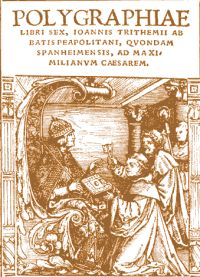
Abbott Johannes Trithemius, wrote the first printed books on cryptology, Steganographia (1508) and Polygraphia (1518). Opus Novum, the second book printed on cryptology, was written by Jacopo Silvestri and was published in 1526. Ciphers and cipher wheels were in common use as the title page suggests:A new work, exceedingly useful to lords of castles, commanders of armies, spies, defenders of the fatherland, travellers abroad, merchants, soldiers, inventors, and all princes devoted to diligence and learning, for correctly writing and interpreting in cipher the Latin, Greek, Italian, and as many other tongues as you will.
A New work, most useful to gentlemen merchants, and to every other sort of person, which teaches how to make many kinds of ciphers according to the practice of ancient and modern lords and princes of the world. And furthermore teaches another kind of cipher, newly discovered, which cannot be read by any human device without knowledge of its solution, explaining that knowing one is not harmful to another one. And further the present work teaches how to decipher many kinds of ciphers by rules, and by other secret methods of deciphering the said ciphers, whether they be made in the Latin tongue, common Greek, or in any other language of any other country whatever, which work is written in the Latin language and repeated in the vulgar tongue.
Leon Battista Alberti was an illustrious mind of the Renaissance period whose scientific and cultural influence surpassed his brief life span. A painter, poet, philosopher, musician, architect and "Father of Western Cryptology", Alberti invented the first published polyalphabetic cipher in 1466. His cipher disk contained two alphabets, one on a fixed outer ring, and the other on a rotating disk, and is the cipher design to which most of today’s systems of cryptography belong: polyalphabetic substitution. Alberti's polyalphabetic cipher was, at least in principle, the most significant advance in cryptography since Julius Caesar's time and marked a great stride forward in cryptology.
THE CODE OF ST. GERMAIN
The unusual triangular shape of the book itself implies the Three Principles of alchemy -- Salt, Mercury and Sulpher -- body, soul and spirit. The upright triangle is a symbol of fire; reversed of water; and interlaced of the union of opposites, also known as the Star of David.
The triangle form could also suggest a triple meaning for the contents of the book: alchemical, kabbalistic and Hermetic. It is a recipe not only for experiencing a symbol in one's inner world but also for manifesting it in reality, for becoming a living embodiment of Spirit. The Triangle is also as essential as the circle in magic. The Triangle of Art, Solomon's triangle of evocation, is a protected space outside the magic circle into which spirits are compelled to appear. Many spirits are called up in St. Germain's Triangle text.

Typically, the central circle is inscribed with the sigil (seal) of the spirit to be invoked. The usual form is of a triangle, circumscribed with various words of power, containing an inner, blackened circle. The purpose of the triangle is to contain the manifested entity. They often have sigils. There is such an illustration in The Triangle Book, too.
The small concentric circle is the place which
you shall take during these operations. The other circle which is below
is the place to be occupied by your Levite
The triangle is a 2-d representation of a pyramid, a virtual resurrection machine. There are 20 triangular faces in an icosahedron, eight in an octahedron, four in a tetrahedron, etc. The triangle, or tetrahedron is the geometric basis of all forms. Precious stones exhibit crystal structures. The atomic structure of the diamond, face-centered cubic close pack, is related to the alchemical squaring of the circle.
The Tetrahedron is the most basic shape to be found in the three dimensional universe of volume. The Merkaba Star Tetrahedron is actually two tetrahedrons interlocked to form a three-dimensional Star of David.
The configuration of the Star Tetrahedron is formed within the first eight cells of life. The Star Tetrahedron also models the energetic body of the human being, the blending of Heaven and Earth, Male and Female. It was called ‘Merkaba’ in the esoteric knowledge of Ancient Egypt.
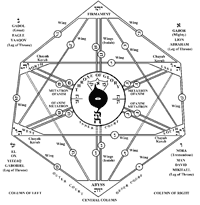
In legend, the Philosopher's Stone is kept in the custody of the reawakened Dragon, the Adept who fully inhabits his or her Body of Light. Alchemy itself is a triple process of uniting the physical, psychological and spiritual. In Masonry, each line of the triangle itself symbolizes a kingdom of nature -- mineral, vegetable and animal. They stand for explorations the Master Mason needs for a complete education.
All these points may be clues to the nature of the "winged dragon" of the title page of The Triangle Book. In alchemy it is a symbol of the volatile elements. Appearing as a symbol of coagulatio in other alchemy texts, it suggests the pandaemonium of psychic images.
Psychologically, the dragon is the union of ordinary human reality with the Transpersonal Self and a passion for transformation. Some now say it is a symbol of DNA or the kundalini energy. Thus, it is a symbol of the Great Work. In the Book of Hermes, Pymander appears to Hermes in the shape of a Fiery Dragon of "Light, Fire, and Flame." Pymander is the "Thought Divine" personified.
This winged dragon is the symbolic superstar of The Triangle Book. In The Book of Lambspring. It represents the Anima Mundi, or Soul of the World, which is the sum total of planetary existence -- the holographic blueprint on which form is based, the informational level or primal source of being. It is said that medicine providing the gift of youth can be made from its venom.
So, the dragon is a healing power. The spiritual food of immortality signifies the ability of the ego to assimilate the previously unconscious aspects of the Self. This is the elixir of youth that creates the immortal body, equivalent to the Philosopher's Stone. The invocation with powerful godnames is combined with the dragon emblem to initiate the current. The rite couldn't be practiced without the Emblems and Sigils.

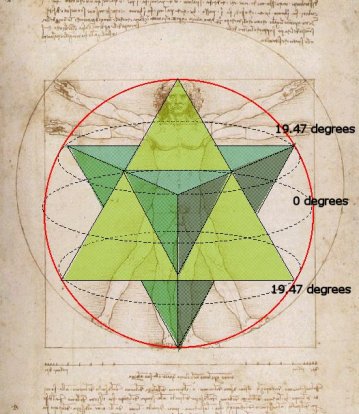
STAR FIRE
The Royal Court Of The Dragon was established in Egypt in 2170 B.C. under Ankhfnkhonsu, and more formally by Queen Sobeknefru in 1783 B.C. to provide an instituation for the pursuit of the work of the Dragon of Al-Khem otherwise known as Thoth or Hermes. From Al-Khem we have alchemy, the Great Work of the Dragon. The most famous books attributed to him are The Emerald Tablets and The Pymander. Dragons, the oldest living creature, have been here through the human history. There had been many legends and manuscripts about these wonderful creatures.
The Translation
The Triangular Book
of the Count of St. Germain
The Holy Magic revealed to Moses discovered within an Egyptian monument
and preciously preserved in Asia under the emblem of a winged dragon.
1. To find things lost in the seas since the flooding of the globe. 2.
To discover mines and diamonds, gold and silver within the bowels of
the earth. 3. To preserve one's health and prolong one's life for a
century, and that with the freshness of fifty years, and the strength of
that age. You should do your operations for the first two objects only
when the sun, earth, and moon are found in conjunction in the same line,
and within the same plane. As for the third marvel, you may perform the
operation at any time, but it is necessary to carry on your person a
figure like that which you see here.
You shall take an appropriate vase (made of any material) and fill it
with fire which you shall exorcise in the following manner:
O Creature of Fire, I excorcise you by Him by whom all things were made
in order that you shall remove from yourself all phantoms.
Bless it, O eternal Father, for the glory of thy holy and immortel Name.
Thou who lives and reigns through all the centuries of the centures.
A Levite which you shall have with you shall respond: AMEN. Next, you
shall bless the incense and four lamps in the following manner: O
eternal God, sovereign Being, bless this incense and these lamps in
order that their strength and their virtue shall augment the fear of
their enemies, that they may not enter herein. Thou who lives and
reigns through all the centuries of the centuries. Your Levite
responds: AMEN.
You shall pour this incense so blessed upon the fire and light the lamps
before your operations. The small concentric circle is the place which
you shall take during these operations. The other circle which is below
is the place to be occupied by your Levite; you shall be clad as in the
days of the sacrificial ceremonies. Upon entering your circle you shall
have in your left hand the following figure. Your Levite shall follow
you in carrying the characters of revelation.
When you shall have arrived at the destined place, you shall give back
to your Levite the figure with which you entered; then the Levite having
occupied his, you shall bless his circle in pronouncing these sacred
words:
NOTAMARGATET, -- bless that circle -- bless it YANODA -- bless it MIOLE
-- bless it ALAG -- bless it AOTHIO -- bless it SORIDIS -- blesws it
APHAL -- bless it AGEMO, bless it THOBASSA -- bless it ARIF -- bless it
BADORA, Thou who lives and reigns through all the centuries of the
centuries. Your Levite shall respond AMEN.
Next you shall invoke the spirits to whom I have given the power to
preside over the hours of the night in commencing from the side where
the sun rises, saying: LEAMAN, LECIAB, LATRANAVIO, RIBRAL, TELARO.
From the side where the sun sets: ELANA, LEPAB, USTAEL, THAERRUB,
SOTARECO, ILIBAPAC.
From the highest side of the circle: ELIA, ELINA, AMIGABIREL.
From the lowest side of the circle: PEDINBAD, FIALECHAM, CHARSIEL.
You shall then make the following invocation on the side where the sun
rises, prostrated upon the ground:
We invoke you YALATINA, and LEMIROT, LESIAB, and TELAR, HERIBAG and
ARNAVIO, TRABA and ARIOT, ANIEL and LEDIMAT, YANAEL and CALMAS, LEASO
and VIANOEL; we command you by Him by whom all things were made and by
all the other names of the ETERNAL, and by these:
IANODA, EL MIHOLES, HOLAE MEBOTH, NOLICSAZ, and NOTAMMARGATEL who is the Lord God exalted before you and represented invisibly near this circle;
let me know by a just inspiration if you judge me to be dignified by the
purity of my soul -- the places where there are mines of diamonds, gold,
and silver, those who find precious things lost in the seas -- to
prolong my life in health and that for a century -- I request these
favors to be granted without incurring danger, risk, or peril, by Y and
V which Adam understood, by the name AGLA for the preservation of Lot
and his family from the fire of Sodom and Gemorrha. By the name Joth,
for the deliverance of Jacob from the persecution of his brother. By
those of SOIGAD, YANADA, THEOS or NOTAMMARGATET, and by the other names
of the ALL-POWERFUL who truly lives and reigns. Such is the WILL of Him
who created all, and Whose empire endures through all the centuries of
the centuries.
Your Levite shall respond: AMEN.
You shall place upon your head with your left hand the figure which you
gave to your Levite; then if your soul is pure, it shall be exalted.
You shall feel yourself to be inspired; you shall lend an attentive ear
to all that which the aerial spirits shall whisper, having care to trace
from right to left on a brass plate the inspired characters which; you
shall bless with these words:
Blessed Be PAO.
THEOS. You may communicate these things to no person because you would
render unworthy my divine bounty and you would not have the success for
which you have obtained hope.
You shall then take the figure which was upon your head with the same
hand; then holding it in both hands and prostrating in adoration you
shall pronounce these characters:
In the name of the Eternal my God, true master of my body, my soul, and
my spirit, go, go in peace; retire that you may accompany me always, and
be ever ready to come when I shall call you.
AMEN and AMEN.
FINIS.
REFERENCES
Cooper-Oakley, Isabel (1970), The Count of St. Germain, Rudolph Steiner Publications
Maurice Magre, 'Magicians, Seers, and Mystics' (1932).
Miller, Iona (1993) "Chaos as the universal solvent." http://www.geocities.com/iona_m/Virtualtantra/universalsolvent.html
Miller, Iona et al, The Modern Alchemist (1994), Phanes Press.
Word, Robert, Triangle Book translation.
